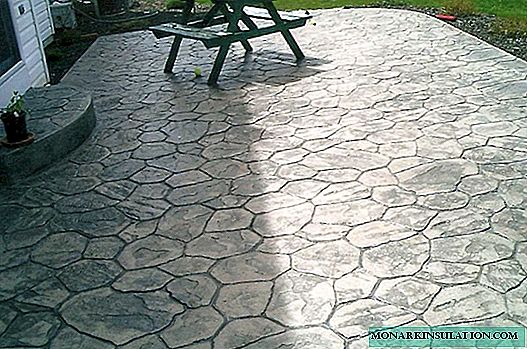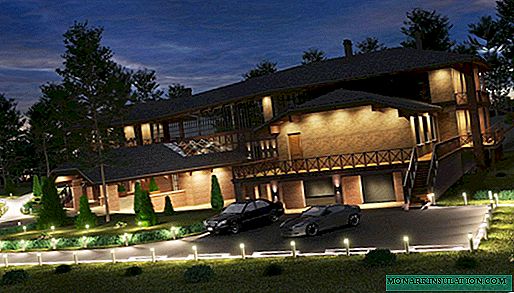
The illumination of the infield is used for various purposes. Most often, light is needed to ensure basic safety. Uninvited guests go around areas where their appearance will not go unnoticed. Another important function is to create a comfortable stay for the owners of the site. Properly lit area with well-placed lighting creates a sense of security. Of particular note is the festive lighting. It is nice if its inclusion will occur, as if by magic. Meanwhile, the remote control of lighting today is turning from a dream into reality.
The use of all technical innovations that can only be used on a garden plot is the choice of a civilized person. The ability to remotely control lighting is no exception. The advantages of this innovation are obvious.
With its help you can:
- to ensure smooth on and off lighting devices;
- adjust the lighting levels of the site;
- extend the life of lighting devices;
- lower power consumption.
Properly organized control of electric light allows you to expand the possibilities of its use in different areas of the garden. Bathing in the illuminated pool or just contemplating the fountain in musical and light accompaniment will not leave anyone indifferent.
There is something magical in a walk along the illuminated paths of the garden and evening gatherings over tea in a beautifully lit gazebo. It is so nice to relax in the evening hours from the daytime summer heat. And the house itself, with the skillful illumination of its architectural details, makes a completely different, pacifying impression.

The fountain is beautiful in itself, but in the evening and after the heat of the day you can not only enjoy its coolness, but also see how beautiful it is if it is correctly illuminated
Article in topic: Solar-powered garden lighting: unnecessary luxury or necessity?
Light Control Equipment
In order to provide remote lighting activation, the following equipment can be used:
- wall-mounted controllers;
- remote control lighting switches;
- personal computer (PC);
- mobile device (phone or smartphone).
Now we will understand the capabilities of each of these devices.
Wall mounted controller
Externally, the wall controller is similar to a conventional switch. It is also used to transmit a signal to turn on or off the light. It can be attached to the wall, having in stock several construction screws. This device is powered by a battery.
Lighting switches and their types
Remote lighting switches are conventionally divided into two groups - infrared and radio-controlled:
- Infrared Today we are so accustomed to remotes, with which you can turn on the TV or switch its channels, that we become completely helpless if this "smart" device is suddenly lost. Improving the control of TVs has spawned many other devices, the commands of which were also given from the remote controls. Further developments contributed to the emergence of electrical devices controlled by infrared rays. The disadvantage of infrared remote controls is their limited coverage: only within sight. Even 12 meters can become an irresistible distance for them.
- Radio-controlled. A radio-controlled lighting switch with radio waves does its job well outside the immediate field of view. It is also important that the clogging of the radio air during the operation of such remotes does not occur. A transmitter with a capacity of 10 milliwatts operating at a frequency of 433 or 868 MHz is sufficient to meet the needs of the garden plot. The range of such a device is 100 meters. However, the presence of natural obstacles can reduce the reception area of its signal. But using a repeater, you can solve this problem.

Remote site lighting switches can be radio-controlled and infrared. Their main difference is the area coverage during signal transmission
Here is an example of a Chinese simple device:
You can also remake an existing remote control in conjunction with a special controller:
PC and light control
You can control the lighting of the house and the plot using a personal computer. Special software has been developed for him. If the owner of the site spends a lot of time working at the computer, then he does not need to use the remote control to control the light - just use your own PC.
A computer is convenient when remote exposure is required. You can, for example, turn off the forgotten light or vice versa, turn it on to create the effect of the presence of the owners of the house.

Both a personal computer and a regular cell phone or smartphone can be used as equipment for remote lighting control with appropriate software
Mobile control
The smartphone in this case performs the same function as the computer. Corresponding software applications can also be loaded into it. Having an ordinary cell phone, you can not only turn the light on and off, but also adjust its intensity. This is done using encoded SMS messages.
Garden lighting scenarios
In order to achieve the above effects from the use of a remote control system for electricity at the site, a thorough study of the project is necessary. It is impossible to start work at random without minimal knowledge in the field of electrics. It is better to involve specialists in such a plan. This they will:
- to develop a detailed plan for the placement of lighting devices on the site, taking into account their power;
- to determine the lighting sectors and the procedure for combining fixtures in a circuit;
- select power cables taking into account the load that is placed on them, lay them in accordance with the developed plan and existing fire safety rules;
- mount the automation panel taking into account the selected backlight scenarios.

The task of developing a plan for the placement of lighting fixtures on the site, taking into account their power and the possibility of combining into a circuit, must be entrusted to specialists
The most commonly used scenarios for lighting a garden plot, a house and a house adjoining territory can be considered the following:
- Festive. The lighting scheme includes a house and a local area. Intended change in intensity and color scheme.
- Evening illumination of the garden. The perimeter of the plot, individual objects (gazebo, for example), architectural forms and paths make up this lighting scheme.
- Romantic. The scheme covers the allocation of certain areas of the site when using dim light and with the inclusion of a garden path. Such zones most often become a pond, fountain, gazebo, etc.
- Disturbing. The scheme covers the entire territory of the site using the blink function.
Article in topic: Interesting ideas for lighting a summer house and a garden + selection of master classes

Properly organized lighting of the house makes it especially cozy and attractive in the evening, and the backlit garden looks inviting and magical.

On the shore of such a fabulous pond with backlight I want to sit for a long time, enjoying the evening cool and spicy aroma of flowers
Commonly used and emergency lighting: lighting elements of the house, gates and gates. When the gate or gate is opened, the backlight of the garage, paths, entrance doors to the house is connected.











